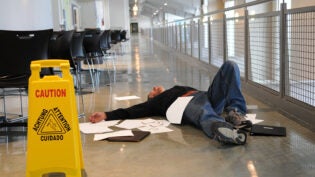5 Safety Issues Caused 65 Percent of Workplace Injuries
By: Susan Solovic

Are you a betting person?
Whether or not you play the lottery or hit Vegas on occasion, you should know what the odds are for any of your employees to get injured on the job and take all the smart steps you can to prevent those injuries.
Counting up workplace injuries reveals these five heavy hitters that, when taken together, account for about 65 percent of all workplace injuries (definitions by the Bureau of Labor Statistics):
- Overexertion involving outside source: 24.4 percent. (Overexertion in lifting, pushing, pulling, turning, throwing, and catching.)
- Falls on same level: 16.4 percent. (Fall on same level while climbing stairs or steps, fall on same level due to uneven surface, fall on same level due to object, fall to same level due to tripping over self.)
- Falls to lower level: 8.7 percent. (Fall from collapsing structure or equipment, fall through surface, other fall to lower level.)
- Struck by object or equipment: 8.6 percent. (Struck by nontransport powered vehicle, struck by rolling object or equipment, struck by falling object or equipment, struck by discharged or flying object, injured by handheld object or equipment, injured by object breaking in hand, injured by slipping or swinging object held by injured worker or other worker.)
- Other exertions or bodily reactions: 6.7 percent. (Bending, crawling, reaching, twisting, climbing, stepping, kneeling, sitting, standing, walking, running, boarding, alighting.)
You’ll immediately see that if you take good measures to prevent the first two items on this list, you’re doing a lot to improve your chances at having an injury-free workplace. Further, we need to take special care training and reinforcing correct lifting procedures and eliminating manual lifting as much as possible.
I also think the “falls on same level” category is one where small business owners can do a lot to improve safety. Many small business owners and employees alike are too prone to leaving boxes and other items in places where they can be easily tripped over. And, as a small business owner, you need to take great care that your facility is in excellent condition regarding evenness of stairs and walkways. And this brings us around to one of the biggest challenges for small business owners.
While larger businesses can afford to have an individual or even a department assigned the responsibility of monitoring and assuring workplace safety, this job often falls to the small business owner or is made an adjunct to one employee’s duties. This can be good in one way—it clarifies communications—but it can be bad if the safety duties are seen as “secondary” to other responsibilities.
With this data in mind, your action items are to systemize and prioritize your safety program and be sure that you have analyzed, trained and retrained your team in appropriate ways so you can minimize these injuries in the workplace.
Unfortunately, it’s easy for a “careless” culture to take over a casual workplace, and the beauty of many small businesses is that they are casual and comfortable places to work. Keep in mind that your company culture starts at the top. If you consistently demonstrate that safety is number one on your list of priorities, that attitude will eventually permeate the majority of your employees.
Finally, as you consider what you must do in your safety program, keep these specific points in mind:
- You must have good onboarding safety training. Write your program and document participation.
- You must have regular training and retraining sessions throughout the year. Document participation.
- You must be reviewing the literature along with any changes in your work routines and facilities to be sure that you are “keeping up with the times.” Use new information to help you keep your training sessions fresh; your employees will start groaning if you give them the exact same lifting tips at every safety meeting.
(Rounding out the top 10 causes of workplace injuries are: Roadway accidents involving motorized land vehicle, 4.8 percent; slip or trip without fall, 3.8 percent; caught in/compressed by equipment or objects, 3.2 percent; struck against object or equipment, 3.0 percent; and repetitive motions involving micro-tasks, 2.9 percent. Data from Liberty Mutual Insurance, U.S. Bureau of Labor Statistics and the National Academy of Social Insurance.)












